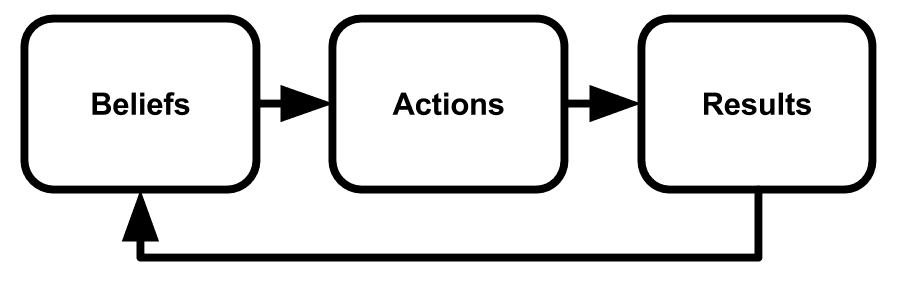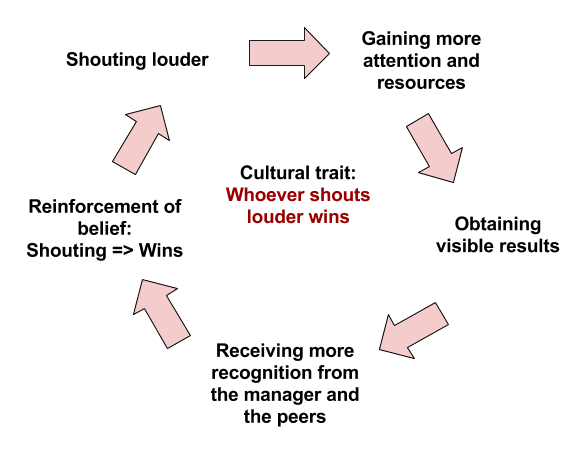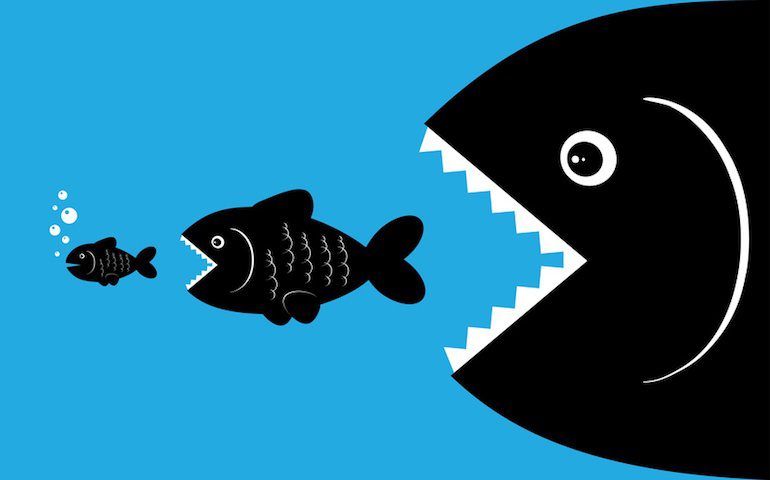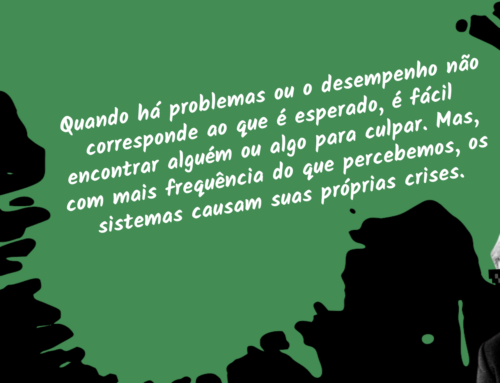Every single company recognizes organizational culture as a fundamental part of its body. It’s a consensus that without a good culture you won’t attract talented people or execute your business plan. Still, most companies don’t know how to manage it. They keep writing useless mission and values statements. But if culture is the result of interaction between all parts of an organization – not what is written on the walls – how can we affect it intentionally?
Culture
We would’t start without a definition! ;)
For us, culture is:
[…] our way of thinking that influences our way of doing, which in turn is reflected in our way of thinking.Difficult? This image explains better:
Culture has everything to do with beliefs, values, and assumptions within an organization. We face culture when we perceive situations like:
- Things here don’t work that way.
- Win who shouts louder.
- To be promoted you have to lick the boss’ boots.
It also manifests itself in what we don’t hear and don’t see. For example, keeping wages private and not talking about it is a cultural trait.
The culture is maintained by feedback cycles of balance or reinforcement, something we wrote about in this post. For example, in a given company there is a cultural trait of whoever shouts louder wins. This can be illustrated by the following reinforcement cycle, which increases the belief over time:
Culture eats strategy for breakfast
Peter Drucker’s famous phrase gives shape to the importance that companies are giving to culture today. For Tony Hsieh, CEO of Zappos, the sustainable success of an organization depends on its culture. In his previous company, Link Exchange, Tony began by inviting his friends to work alongside him. As the company grew, the friends to hire ended and the company’s cultural identity was lost. Tony eventually sold Link Exchange to Microsoft, for not being able to work there anymore.
You can have the best strategy, the best business plan and the most qualified people. However, if the organization does not have the right culture to run the business and put people’s skills into use, you will end up having nothing.
The problem with culture is that companies have no idea how to deal with it. You can’t just change it. Culture is something that emerges from many other elements of your organization, such as structure, space, governance, processes, purpose, meetings, people, goals, and so on. The list is endless!
If the culture can’t be changed directly, how can we affect it?
Structure eats culture for dinner
That phrase is not so famous, but was quoted by the American businessman Brian Robertson, creator of Holacracy. What Robertson meant is that no matter how well-intentioned you are, what gives body to an organizational culture is how you put it into practice.
At Target Teal we use artifacts to help other organizations change their culture. An artifact is a practical experiment that intends to change a cultural trait of an organization. They do it through the elements we mentioned earlier, such as space, governance, processes, purpose, meetings, people, and goals. For example, to break the previous cycle of whoever shouts louder wins we could propose the following artifacts:
- Meetings with rounds, where everyone has the same space to speak and can’t interrupt the colleague;
- A decision-making process with a facilitator elected by the group;
- An achievement wall, where everyone in the group can show their top achievements in recent weeks. This would avoid that only some few would get visibility;
Any artifact you propose will be based on a premise. For example, we believe that when creating meetings with rounds (artifact), we will have a reduction of the whoever shouts louder wins culture, since everyone will have the same voice at the meeting (premise). This is a hypothesis that needs to be validated during the process. The artifact is adapted as we learn more.
We call this process of changing culture through intentional artifacts of Cultural Design.
Culture is the product of many other elements of your organization. Therefore, direct your energy in changing those elements. Create practical artifacts that manifest the desired culture in an intentional and concrete way. Treat them as experiments, with hypotheses that need to be validated. Do not forget that structure eats culture that eats strategy! If you need help, reach us ;)









Leave A Comment